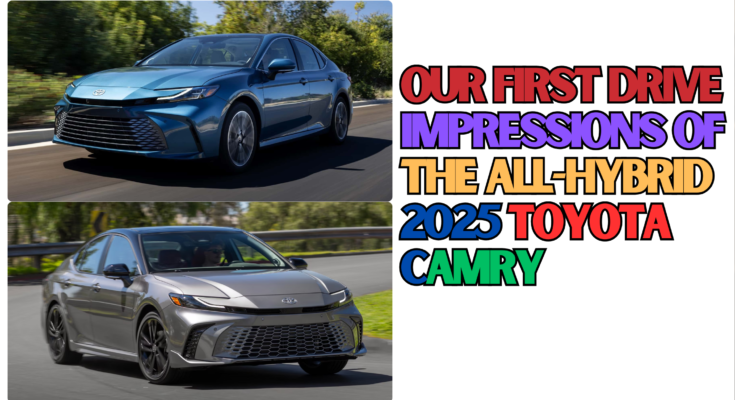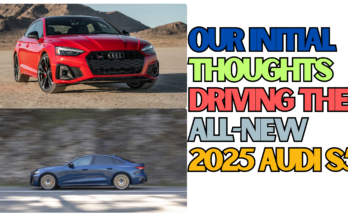The Toyota Camry. It’s practically a household name in America, known for decades as the reliable, comfortable, sensible midsize sedan choice for millions. But for 2025, Toyota threw a curveball – a big one. Say goodbye to the gasoline-only four-cylinder and the powerful V6 options. The ninth-generation 2025 Toyota Camry is now exclusively a hybrid.
That’s right, every single new Camry rolling off the line pairs a gasoline engine with electric motors. This is a bold move, banking on the idea that incredible fuel efficiency and smooth power delivery are what today’s sedan buyers really want. But does ditching the traditional engines change the Camry’s soul? Does it still feel like the dependable car we all know, just… better?
We’ve gathered all the details and synthesized the initial driving experiences to bring you our “First Drive Review.” We’ll dive deep into how this new hybrid powertrain feels, what the fuel savings really look like, how it handles, the massive tech upgrades inside, and whether this reinvented staple still holds its crown. Let’s get behind the wheel (figuratively speaking!) of the 2025 Toyota Camry.
Hybrid Power Takes the Wheel: Understanding the 2025 Camry Powertrain
The biggest story here is under the hood. Toyota didn’t just offer a hybrid option; they made it the only option. Why? It aligns with Toyota’s push for electrification and responds to increasing demand for fuel-efficient vehicles without going full-electric yet.
- The Heart of the System: Powering the 2025 Camry is the 5th generation Toyota Hybrid System (THS 5). This isn’t brand new tech for Toyota (they’ve been leaders in hybrids for ages), but it’s the latest and most refined version. It pairs a 2.5-liter four-cylinder gasoline engine with electric motors.
- Power Output:
- Front-Wheel Drive (FWD): The standard setup delivers a combined system output of 225 horsepower. That’s actually more horsepower than the outgoing four-cylinder gasoline Camry.
- All-Wheel Drive (AWD): For the first time ever on a Camry Hybrid, you can get Electronic On-Demand All-Wheel Drive (e-AWD). This adds a dedicated electric motor to the rear axle, providing extra traction when needed. The AWD models boast a slightly higher 232 combined horsepower.
- How e-AWD Works: Think of it as smart traction. In normal driving, it primarily operates in FWD for efficiency. But if the system detects slippage (like on wet or snowy roads, or during hard acceleration), it instantly sends power to the rear wheels via that electric motor – no complex driveshaft needed. It’s seamless and efficient.
- Transmission: The power is managed by an electronically controlled Continuously Variable Transmission (eCVT). Modern eCVTs are much better than older CVTs. They are designed to smoothly blend power from the gas engine and electric motors, keeping the engine in its most efficient operating range.
Our First Drive Feel (Synthesized): So, what’s it like to drive? Reports indicate the first thing you notice is the smoothness. The transition between electric-only driving (at lower speeds or when coasting) and the gasoline engine kicking in is incredibly refined – often barely perceptible. Acceleration from a stop feels instantly responsive, thanks to the immediate torque from the electric motors. It gets up to speed briskly and confidently for merging onto highways or making passes. While it doesn’t have the V6’s roar or top-end rush, the hybrid system provides more than enough power for everyday driving, feeling surprisingly energetic. The eCVT operates unobtrusively most of the time, though like many CVTs, you might hear the engine drone a bit if you floor the accelerator for extended periods. Overall, the impression is one of quiet competence and effortless efficiency.
The MPG King? Fuel Economy Takes Center Stage
Let’s talk about the headline benefit: fuel economy. This is where the hybrid-only strategy pays off big time.
- Stellar Numbers: Official EPA estimates are impressive. The base LE FWD trim is rated as high as 53 mpg city / 50 mpg highway / 51 mpg combined. That’s phenomenal for a midsize sedan!
- Trim Variations: Fuel economy varies slightly depending on the trim level and drivetrain.
- Sportier trims (SE, XSE) and luxury trims (XLE) often have slightly lower figures due to different wheel/tire packages, perhaps around 47-48 mpg combined for FWD models.
- Adding AWD usually results in a small dip, but figures are still expected to be excellent, likely in the mid-to-high 40s mpg combined (e.g., LE AWD around 50 combined, XSE AWD around 46 combined).
- Real-World Savings: These numbers translate directly to fewer trips to the gas station and significant savings on fuel costs over the life of the car. The driving range on a single tank is also very impressive.
Our First Drive Feel (Synthesized): The car practically encourages efficient driving. The dashboard displays provide clear feedback on energy flow (engine, battery, wheels) and your current fuel economy. Driving smoothly allows the car to maximize time spent in EV mode, especially around town. The system is so well-integrated that achieving those high MPG numbers doesn’t require hypermiling or special effort – just drive normally, and the efficiency follows. It feels good knowing you’re sipping fuel while enjoying a comfortable ride.
Hitting the Pavement: Ride Comfort and Handling Dynamics
The 2025 Camry rides on Toyota’s well-regarded TNGA-K platform, but Toyota engineers have retuned the suspension and steering for this new generation.
- Ride Quality: Comfort remains a priority. The suspension effectively soaks up bumps and road imperfections, providing a smooth and quiet ride, especially on the highway. The LE and XLE trims feature a standard suspension tuned for maximum comfort.
- Sportier Edge (SE/XSE): The SE and XSE trims get a sport-tuned suspension. This doesn’t turn the Camry into a track weapon, but reviewers note it provides slightly firmer damping, better body control (less leaning in corners), and a more connected feel to the road without being harsh.
- Handling: While still prioritizing comfort, the 2025 Camry feels more composed and responsive than previous generations. The steering is reported to be light but accurate, making it easy to maneuver around town and stable on the freeway. It’s not trying to be a sports sedan, but it handles corners confidently.
- Braking: Toyota has significantly improved the feel of its regenerative braking systems over the years. The 2025 Camry’s brakes feel much more natural and linear. The system captures energy during deceleration to recharge the hybrid battery, but the transition between regenerative braking and the traditional friction brakes is smooth and predictable.
- AWD Confidence: The available e-AWD system adds peace of mind and tangible grip, especially in regions with inclement weather, without a huge fuel economy penalty.
Our First Drive Feel (Synthesized): The overall impression is one of enhanced refinement and composure. It’s still unmistakably a Camry – quiet, comfortable, and easy to drive – but it feels more buttoned-down. Bumps are absorbed gracefully, especially in the LE/XLE. The SE/XSE feel noticeably tighter in corners, offering a bit more engagement for drivers who enjoy a winding road, yet still comfortable enough for daily duty. The quietness of the hybrid powertrain at lower speeds adds to the relaxing atmosphere inside. It’s simply a pleasant car to spend time in, whether commuting or on a road trip.
Sharp New Threads: Exterior and Interior Transformation
Toyota didn’t just change the powertrain; they gave the 2025 Camry a significant makeover inside and out.
- Exterior Design: The look is evolutionary but definitely modernized.
- Front End: The most striking change is the “hammerhead” front fascia, similar to the latest Prius and Crown, featuring slim LED headlights and a wide lower grille.
- Trim Differences: LE/XLE trims have a sleeker grille pattern, while SE/XSE get a sportier mesh grille, black accents, side skirts, a small rear spoiler, and exposed dual exhaust tips (even though it’s a hybrid!).
- Profile: The overall shape is sleek and aerodynamic. Wheel sizes range from 16 inches on the LE to 19 inches on the XSE. Several new colors are available, like Ocean Gem and Heavy Metal.
- Interior Redesign: This is where the transformation feels most dramatic.
- Dashboard: A modern, horizontally oriented layout replaces the older design. Materials feel substantially upgraded, with more soft-touch surfaces and attractive trim pieces (like patterned metal film or textured fabric depending on trim).
- Screens: A large touchscreen infotainment system (8-inch standard, 12.3-inch available) is nicely integrated, alongside a digital instrument cluster (7-inch standard, 12.3-inch available).
- Trim Ambiance: LE is neat and functional (fabric seats). SE adds sporty touches and SofTex (synthetic leather). XLE goes for luxury with leather and microfiber standard, plus more ambient lighting. XSE blends SE’s sportiness with XLE’s features, offering unique finishes like available bright red SofTex/leather interiors.
Our First Drive Feel (Synthesized): Visually, the 2025 Camry looks sharper and more contemporary. It has more presence on the road. Stepping inside feels like entering a much more modern and upscale environment. The dashboard design is clean, the screens are well-placed, and the materials, especially on XLE and XSE trims, feel genuinely premium for this class. It’s a significant leap forward in perceived quality and design appeal compared to the previous generation.
Serious Tech Upgrade: Infotainment and Connectivity
The 2025 Camry gets Toyota’s latest technology suite, addressing a common critique of older models.
- Toyota Audio Multimedia: This system is a huge improvement.
- Screen Sizes: Standard 8.0-inch touchscreen on LE/SE, available 12.3-inch touchscreen standard on XLE/XSE.
- Features: Wireless Apple CarPlay and Android Auto are standard across the board. The system is responsive, features clear graphics, and supports Over-The-Air (OTA) updates for future enhancements. Voice commands (“Hey Toyota”) work well for various functions.
- Digital Displays:
- Standard 7.0-inch digital instrument cluster for the driver.
- Available 12.3-inch fully digital, customizable instrument cluster (standard on XLE/XSE) looks fantastic and provides a wealth of information.
- Convenience Tech: Available features include a 10-inch Head-Up Display (HUD), a 9-speaker JBL premium audio system, a wireless charging pad, multiple USB-C ports, and even a Digital Key capability that lets you use your smartphone as the key (requires a subscription).
Our First Drive Feel (Synthesized): The tech integration is seamless and user-friendly. The large screens are easy to see and operate. Wireless smartphone mirroring connects quickly and reliably. Having the large 12.3-inch digital cluster and the HUD (on equipped models) makes accessing driving information effortless. It finally feels like the Camry has caught up and, in some ways, surpassed competitors in terms of standard and available cabin technology.
Safety Always: Toyota Safety Sense 3.0 Standard
Safety remains a core Toyota value, and every 2025 Camry comes standard with Toyota Safety Sense 3.0 (TSS 3.0).
- Key TSS 3.0 Features:
- Pre-Collision System with Pedestrian Detection: Helps detect vehicles or pedestrians and provides warnings or automatic braking.
- Full-Speed Range Dynamic Radar Cruise Control: Maintains a set distance from the car ahead, down to a stop.
- Lane Departure Alert with Steering Assist: Warns you if you drift out of your lane and can provide gentle steering input.
- Lane Tracing Assist: Helps keep the vehicle centered in its lane when cruise control is active.
- Road Sign Assist: Reads certain road signs (like speed limits) and displays them.
- Proactive Driving Assist: Provides subtle braking into curves or gentle braking/steering to help support driving tasks like maintaining distance.
- Automatic High Beams: Switches between high and low beams automatically.
- Available Safety Options: Blind Spot Monitor with Rear Cross-Traffic Alert is standard on XLE/XSE (optional on LE/SE). Higher trims also offer options like a Panoramic View Monitor (360-degree camera) and Front and Rear Parking Assist with Automatic Braking.
Our First Drive Feel (Synthesized): The standard suite of safety features is comprehensive and provides significant peace of mind. The systems generally work smoothly in the background. The adaptive cruise control and lane tracing assist make highway driving less fatiguing. Proactive Driving Assist is subtle but noticeable, gently helping manage speed and distance in certain situations. Knowing this level of safety tech is included on every trim adds considerable value.
Trim Levels Explained: Finding Your Fit (LE, SE, XLE, XSE)
Toyota streamlined the trim lineup for 2025, making choices clearer:
- LE: The sensible starting point. Gets fabric seats, the 8-inch touchscreen, 7-inch driver display, dual-zone auto climate, 16-inch alloy wheels, and TSS 3.0. Offers the best potential fuel economy. (Starts around $28,400)
- SE: Adds a sporty flavor. Includes the sport-tuned suspension, sportier exterior styling (grille, spoiler, black accents), 18-inch black alloy wheels, SofTex seats with sporty bolsters, and paddle shifters. (Starts around $30,700)
- XLE: Focuses on comfort and luxury. Builds on LE with leather & microfiber seats, heated front seats, the 12.3-inch touchscreen and 12.3-inch driver display standard, ambient lighting, acoustic laminated front side glass (for quieter cabin), wireless charging, and Blind Spot Monitor/RCTA standard. Uses the comfort suspension and 18-inch alloy wheels. (Starts around $33,400)
- XSE: The top dog, blending sport and luxury. Combines the SE’s sport-tuned suspension and aggressive styling (unique grille, 19-inch wheels) with the XLE’s luxury features (leather standard, big screens, etc.). Offers unique interior options like the striking red leather. (Starts around $34,600)
Crucially, AWD is available as an option on all four trim levels.
Still Practical? Space and Everyday Use
Despite the new tech and hybrid focus, the Camry remains a highly practical midsize sedan.
- Passenger Room: Plenty of space for four adults to ride comfortably, with good legroom and headroom in both the front and rear seats.
- Cargo Space: The trunk offers ample cargo volume, suitable for groceries, luggage, or strollers. The hybrid battery is located under the rear seat, so it doesn’t impede trunk space compared to the outgoing gas model. Rear seats typically fold down (likely a 60/40 split) for carrying longer items.
- Comfort: Features like standard dual-zone automatic climate control, available heated/ventilated seats, and a heated steering wheel ensure comfort in various conditions.
Our First Drive Feel (Synthesized): Yes, it’s absolutely still a comfortable and practical car. It excels as a daily commuter, family hauler, or road trip companion. The added refinement of the hybrid powertrain and the quieter cabin (especially XLE/XSE) make it even more pleasant for everyday use.
The Bottom Line: Value, Pricing, and Competition
Pricing for the 2025 Camry starts reasonably, especially considering the standard hybrid powertrain and extensive feature list.
- Starting MSRPs (approximate, excluding destination):
- LE FWD: ~$28,400
- SE FWD: ~$30,700
- XLE FWD: ~$33,400
- XSE FWD: ~$34,600
- Adding AWD typically costs around $1,500 extra.
- Value: When you factor in the fuel savings, standard safety tech, modern infotainment, and Toyota’s strong reputation for reliability and resale value, the 2025 Camry presents a compelling value proposition.
- Competition: Its main rival is the Honda Accord, which also heavily emphasizes hybrid powertrains. Other competitors include the Hyundai Sonata Hybrid and Kia K5 (which offer stylish alternatives). The Camry’s key advantages are often its potentially superior fuel economy (especially LE), the availability of AWD across all trims (Accord Hybrid is FWD only), and that legendary Toyota dependability factor.
Final Takeaway: Our First Drive Verdict on the 2025 Camry
The move to an all-hybrid lineup for the 2025 Toyota Camry might seem risky, but based on initial impressions and reported experiences, it’s a resounding success. Toyota has managed to enhance the Camry’s traditional strengths – comfort, reliability, practicality, value – while significantly boosting fuel economy and modernizing the technology and design.
The hybrid powertrain is smooth, adequately powerful, and incredibly efficient. The ride is comfortable yet more composed than before, especially in the sportier trims. The interior is a massive step up in terms of design, materials, and technology. And with standard TSS 3.0 and available AWD, it covers all the bases for safety and capability.
Is the absence of a non-hybrid base model or a potent V6 a loss? For a small subset of previous buyers, perhaps. But for the vast majority shopping for a midsize sedan in 2025, the benefits of the standard hybrid system – particularly the fuel savings and refinement – far outweigh the loss of the old engines.
The 2025 Toyota Camry isn’t just coasting on its reputation; it has been thoughtfully reinvented for a new era, solidifying its position as a top choice for anyone seeking a dependable, efficient, and thoroughly modern midsize sedan. It successfully blends the familiar with the future.




